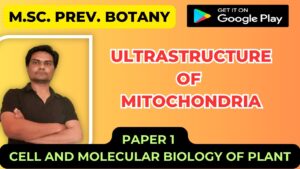![]()
NUCLEOLUS AND RIBOSOMAL RNA GENES
Nucleolus
- Nucleolus was discovered by Fontana in 1781.
- The term nucleolus was coined by Bowman (1840).
- Nucleolus is the most prominent sub-structure with in the nucleus.
- It is the site of rRNA transcription and processing and of ribosome assembly.
- It is a ribosome production factory, designed to fulfill the large scale production of rRNAs and assembly of the ribosomal subunits.
- It is a rounded colloidal body without surrounding membrane.
- It is a spheroidal body situated with in the nucleus, either in central or peripheral position.
- It is found in close association with the nucleolar organizer region(NOR) of two or more chromosome.
- It is also called as plasmasomes and is mainly consist of rRNA and protein.
- Actively synthesizing cells have large nucleoli.
- Nucleolus disappears during late prophase and reappears during telophase of mitosis and meiosis.
- During prometaphase to early telophase, when the nucleolus remains disappeared, a number of non-ribosomal nucleolar proteins as well as U3 s- RNA are found in
- (i) the peripheral regions of chromosomes and in the
- b(ii) nucleolus derived foci (NDF) found as cytoplasmic particles 1-2 in diameter;
- Nucleolus stains with acidic dyes. (Pyronin)
Evolution
- Its development is relatively late in evolution as many lower species like yeasts and bacteria lack nucleoli.
- Nucleolus is also absent in some algae and undifferentiated embryonic cells.
- Also absent in certain mammalian cells like erythrocytes, reticulocytes and spermatozoa.
Number and Structure
- One or many may be present in a nucleus.
- Its number depends on the number of chromosomes in the species.
- For each haploid set of chromosomes in the nucleus, there is a single nucleolus.
- However, a pair of nucleoli may be found in haploid nuclei.
- In human beings, two pairs of nucleoli are found in each diploid nuclei.
- Xenopus oocytes may contain upto 1000 nucleoli in the nucleoli in the nucleus.
Structure
Morphologically nucleolus consists of three regions:

- The ultrastructure of nucleolus was studied by Borysko and Bang in 1951 and again by Berhard in 1952. On the basis of electron microscopic studies of the structure of nucleolus, de Robertis et al., (1971) described it to be made up of four parts:
Fibrillar regions:
- This part is made up of ribonucleoprotein fibres. It is also called nucleolemma. Each fibre has a length of around 50-80 Å.
Granular regions :
- This part has many granules each having the diameter of 150-200 Å. These are derived from nucleolar fibres, chemically, these granules are also ribonucleoproteins.
Protein region:
- This proteinous part is also called parsamorpha. This is the fluid part of nucleolus in which other parts are found.
Chromatin part:
- It is made up of chromatin fibres containing DNA. These DNA molecules function as template for RNA synthesis. The chromatin part may be differentiated into two parts
Perinucleolar Chromatin:
- it forms a covering or envelope around nucleolus. It may have ingrowths at certain places inside the nucleolus, which are called trabeculae.
Intranucleolar chromatin:
- These chromatin fibres are found in internal protein region. These form many septa like structures.

- Each nucleolus has dense fibrillar region due to presence of which it is associated with nuclear organizer region of chromosomes.
- These region have been reported to contain many copies of DNA responsible for synthesis of ribosomal RNA.
- These rRNA molecules are rapidly synthesized in this region.
- The protein of ribosomes are synthesized in the cytoplasm which is transported to nucleus and finally to nucleolus.
- The rRNA and protein molecules combine to form complete ribosome molecules. These newly
- synthesized ribosomes are associated with thin fibrils of RNA and look like beaded string.
- This structure is called nucleonema.
- On the basis of the presence and structure of nucleonema, following three types of nucleoli may be recognized:
- Nucleolus with nucleonema which is more common is all types of cells.
- Nucleolus without nucleonema which is commonly found in salivary gland cells.
- Ring shaped nucleolus containing ribonucleoprotein granules and RNA fibrils.
- This is common in endothelial cells and muscle cells.
Functions:
- Nucleoli are the site of rRNA biosysthesis.
- It stores rRNA.
- It helps in the biogenesis of ribosomes.
- It helps in the formation of spindle fibres.
- It plays important role in mitosis.
Chemical Composition of nucleolus:
- Nucleolus is not bounded by any limiting member and Ca++ ions are supposed to maintain its intact organization. Chemically, nucleolus contains DNA of “NO” , 4 types of rRNAs, 70 s types of ribosomal proteins, RNA binding proteins (e.g., nucleolin) and RNA splicing nucleoproteins (U1, U2, …..U12) .It also contains phospholipids, orthophosphates and Ca++ ions.
- Also contain some enzymes such as acid phosphatase, nucleoside phosphorylase and NAD+ synthesizing enzymes for the synthesis of some coenzymes, nucleotides and ribosomal RNA.
- RNA methylase enzymes which transfers methyl groups to the nitrogenous bases, occurs in the nucleolus of some cells.
Function of Nucleolus:
- It is site of biogenesis of ribosomal subunits (i.e. 40s and 60s).3 types of rRNAs, namely 18s, 5.8s and 28s are transcribed as parts of much longer precursor molecules (45s transcript) which undergoes processing (RNA splicing) by the help of 2 types of proteins such as nucleolin and U3 snRNP (small nuclear ribonucleoprotein).5S rRNA is transcribed on the chromosome existing outside the nucleolus and 70 types of ribosomal proteins are synthesized in the cytoplasm.
- All these components migrate to the nucleolus, where they are assembled into 2 types of ribosomal subunits which are transported back to the cytoplasm.
- Smaller subunits (40S) are formed and transported much earlier than 60S.Such a time tag in migration of 40S and 60S prevents functional ribosome from gaining access to incompletely processed HnRNA inside the nucleolus.
Ribosomal RNA Genes
- Nucleolus is organized around the chromosomal regions that contain the genes for the 5.8S, 18S and 28S rRNA which are therefore called as Nucleolar Organizing Regions (NOR).
- All organisms have multiple rRNA genes. In the case of Xenopus, each nucleolar organizer contains 450 rRNA genes.
- These genes are tandemly repeated along the DNA molecule and separated from each other by stretches of spacer DNA which is not transcribed.
- These rRNA genes are being actively transcribed and the nascent RNA chains are spread perpendicularly to the DNA axis.
- Each gene is transcribed into a RNA molecule which will eventually be processed giving rise to 18S, 28S and 5.8S rRNA.
- As each gene has fixed initiation /promoter site and fixed termination site, the transcript adopts the characteristic”Christmas tree” configuration. Nucleolar rRNA genes are transcribed by RNA polymerase I.
- Eukaryotic ribosomes contain 4 types of RNA i.e. 5S, 5.8S, 18S and 28S.Out of these 4, 5.8S, 18S and 28S transcribed as single unit within the nucleolus by RNA polymerase I as 45S ribosomal precursor RNA.
- The 45S rRNA processed to the 18S rRNA of 40S and 5.8S and 28S of 60S .5S transcribed out of nucleolus by RNA polymerase III and is part of 60S.

Fig Biogenesis of ribosomes
- Ribosomal proteins are imported to the nucleolus from the cytoplasm and begin to assemble on pre-rRNA prior to its cleavage. As pre-rRNA is processed, additional ribosomal protein and 5S rRNA assemble to form preribosomal particles.
- Final step of maturation follows the export of preribosomal particles to the cytoplasm yielding 40S and 60S ribosomal subunits.



